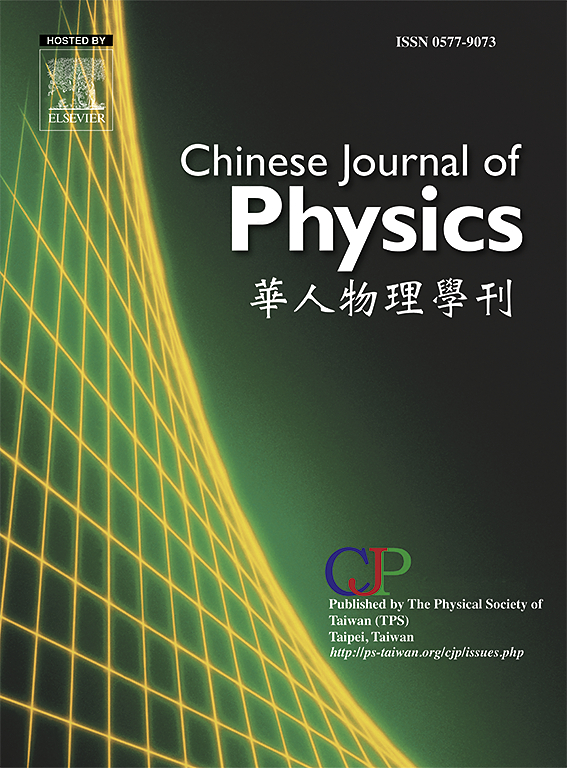Nuclear structure and β decay properties of astrophysical significant A = 56 isobars
IF 4.6
2区 物理与天体物理
Q1 PHYSICS, MULTIDISCIPLINARY
引用次数: 0
Abstract
This study explores the ground-state properties and weak transition rates of =56 isobars including 56Ni, 56Co, 56Fe, 56Mn, 56Cr and 56V. The nuclear ground-state properties of selected nuclei were examined using the relativistic mean field (RMF) model. The RMF model with density-dependent interactions DDME2 and DDPC1 is utilized to analyze the deformation parameters, potential energy curves and surfaces, neutron skin thickness, neutron separation energies and nuclear radii. The deformation parameter computed via the RMF model is then utilized as an input parameter in the proton–neutron quasiparticle random phase approximation (pn-QRPA) model for the analysis of the Gamow–Teller (GT) strength distributions, half-lives and the stellar rates. The computed GT strength distributions align well with the experimental values and the predicted decay half-lives are within factor 10 of the measured data. Stellar rates [() and ()] were computed and compared with earlier computations based on the large-scale shell model (LSSM) and the independent particle model (IPM). For selected isobars, at high-density regime with increasing core temperature, the () rates calculated using the pn-QRPA model were up to an order of magnitude lower than those obtained with the LSSM and IPM models. The computed () rates were up to six orders of magnitude smaller than those obtained from the LSSM and IPM calculations. The computed stellar rates could provide valuable inputs for -process nucleosynthesis simulations of the post-core silicon burning phases in stellar evolution.

天体物理意义的A = 56等压线的核结构和β衰变性质
本文研究了56Ni、56Co、56Fe、56Mn、56Cr和56V等压线的基态性质和弱跃迁速率。用相对论平均场(RMF)模型研究了选定原子核的基态性质。利用具有密度依赖相互作用的RMF模型DDME2和DDPC1分析了变形参数、势能曲线和曲面、中子表皮厚度、中子分离能和核半径。然后利用RMF模型计算的变形参数作为质子-中子准粒子随机相位近似(pn-QRPA)模型的输入参数,用于分析Gamow-Teller (GT)强度分布、半衰期和恒星速率。计算的GT强度分布与实验值吻合良好,预测的β衰变半衰期与实测数据相差在10倍以内。计算了恒星速率[(β++EC)和(β−+PC)],并与先前基于大尺度壳层模型(LSSM)和独立粒子模型(IPM)的计算结果进行了比较。对于选定的等压线,在高密度状态下,随着核心温度的升高,使用pn-QRPA模式计算的(β++EC)速率比LSSM和IPM模式计算的速率低一个数量级。计算得到的(β−+PC)速率比LSSM和IPM计算得到的速率小6个数量级。计算得到的恒星速率可以为恒星演化过程中后核硅燃烧阶段的rp过程核合成模拟提供有价值的输入。
本文章由计算机程序翻译,如有差异,请以英文原文为准。
求助全文
约1分钟内获得全文
求助全文
来源期刊

Chinese Journal of Physics
物理-物理:综合
CiteScore
8.50
自引率
10.00%
发文量
361
审稿时长
44 days
期刊介绍:
The Chinese Journal of Physics publishes important advances in various branches in physics, including statistical and biophysical physics, condensed matter physics, atomic/molecular physics, optics, particle physics and nuclear physics.
The editors welcome manuscripts on:
-General Physics: Statistical and Quantum Mechanics, etc.-
Gravitation and Astrophysics-
Elementary Particles and Fields-
Nuclear Physics-
Atomic, Molecular, and Optical Physics-
Quantum Information and Quantum Computation-
Fluid Dynamics, Nonlinear Dynamics, Chaos, and Complex Networks-
Plasma and Beam Physics-
Condensed Matter: Structure, etc.-
Condensed Matter: Electronic Properties, etc.-
Polymer, Soft Matter, Biological, and Interdisciplinary Physics.
CJP publishes regular research papers, feature articles and review papers.
 求助内容:
求助内容: 应助结果提醒方式:
应助结果提醒方式:


